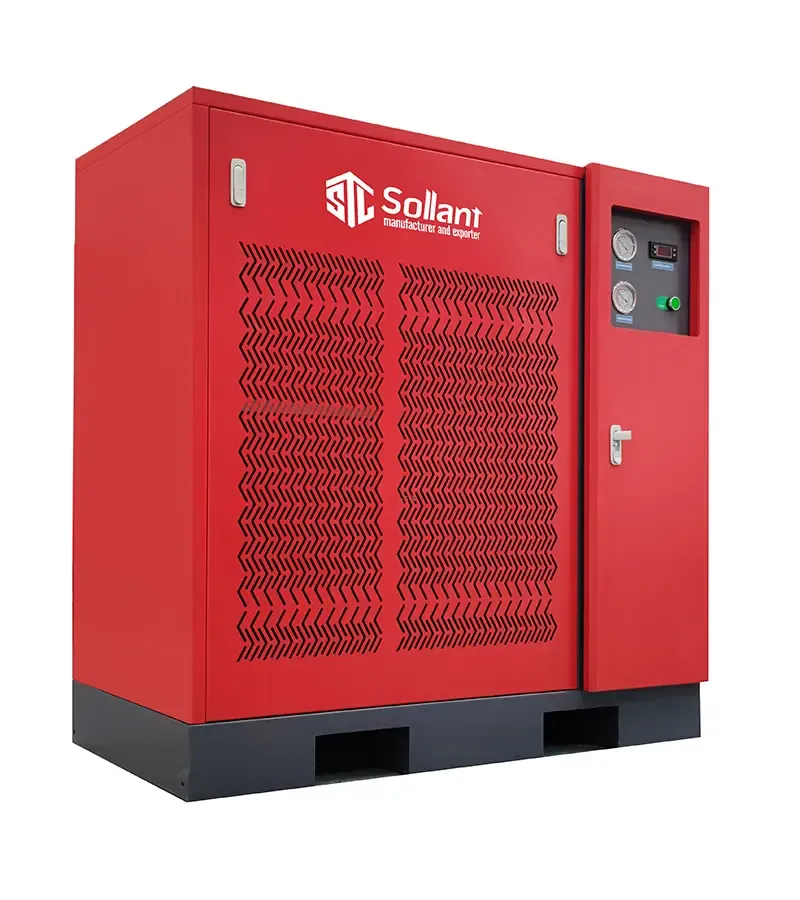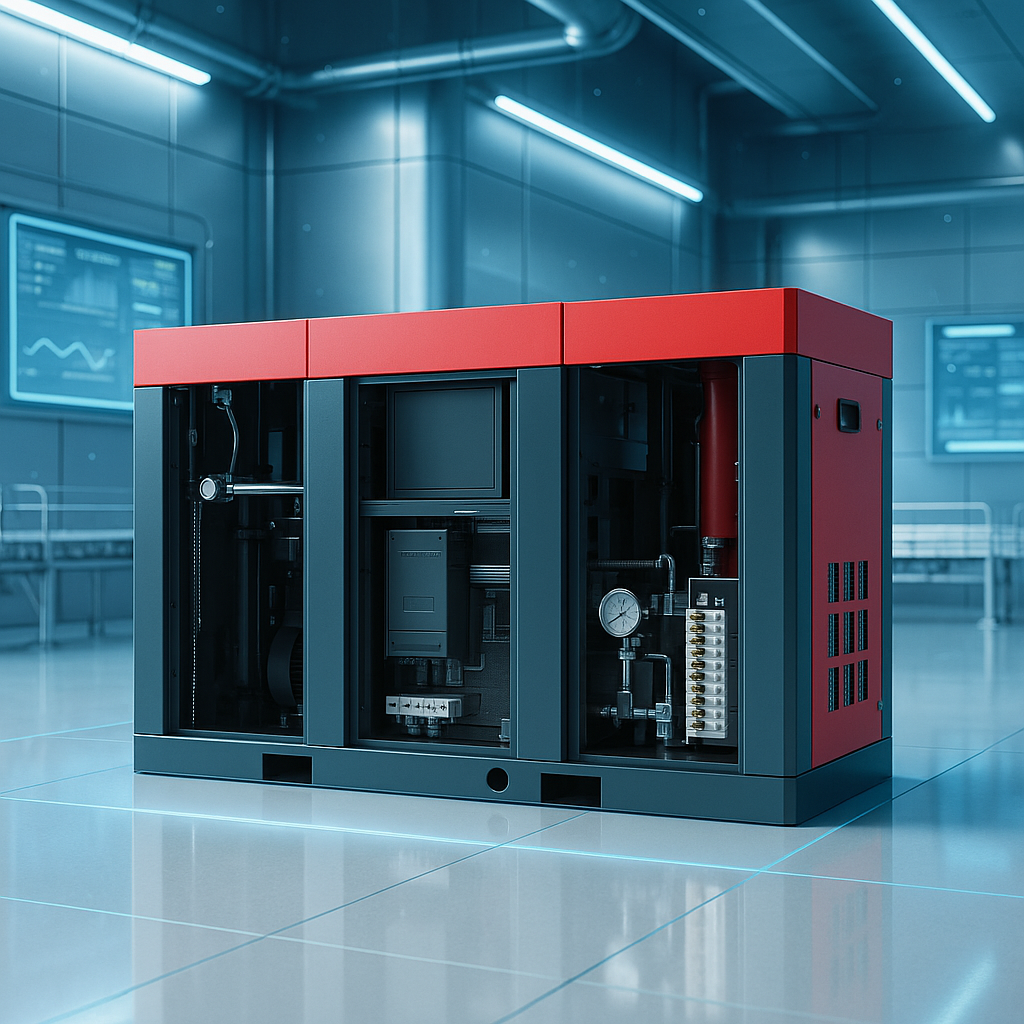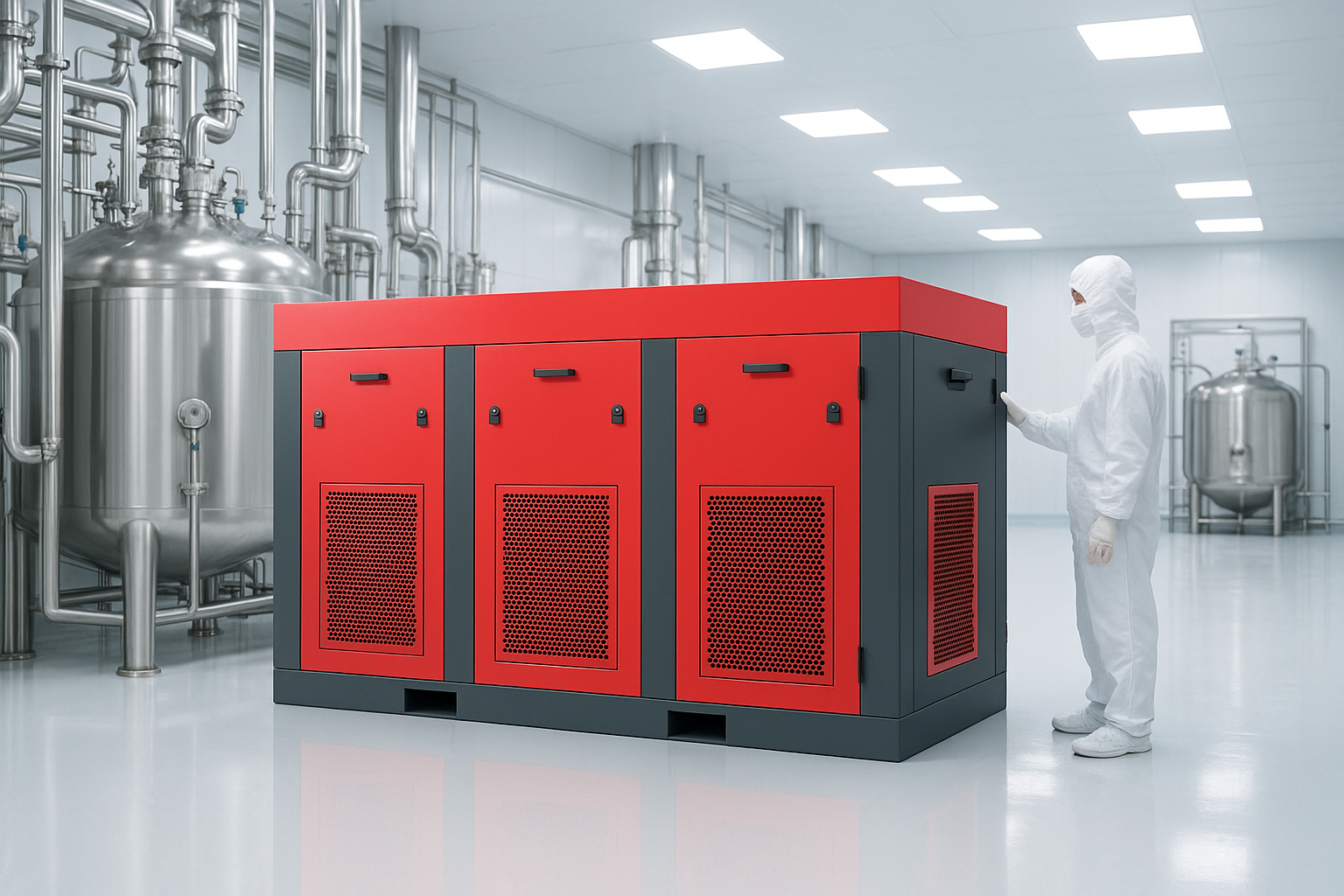Essential Tips for Installing Rotary Compressors with Dryers

You want your rotary compressor with dryer to be safe. You also want it to last a long time. Many people have problems when setting it up. Some problems are high temperatures, bad drainage, and loud noise. If you skip safety checks, water can build up. Your machine might get too hot. Here are some common problems and what causes them:
Challenge | Symptoms | Causes |
|---|---|---|
Decreased Drying Efficiency | Water build-up, bad air quality | Dirty condenser, not enough refrigerant |
Abnormal Temperatures | Gets too hot, shuts off | Cooling system not working |
Excessive Noise | Loud sounds, shakes | Pipes are loose, fan problems |
Poor Drainage | Water stays, valve does not work | Pipes are blocked, valves are broken |
Sollant gives you good solutions and tips for safe setup.
Table of Contents
Key Takeaways
Pick a spot that is clean and dry for your rotary compressor. This helps it work well and last a long time.
Check for safety before you install it. Make sure pressure relief devices and electrical grounding work. This helps stop accidents.
Use the correct materials for air pipes. Do not use quick couplings. This helps stop leaks and keeps the right pressure.
Plan regular maintenance checks. Look at filters, oil levels, and belts often. This helps you find problems early and saves money on repairs.
Test the air quality often. Follow world standards to keep your air system safe and working well.

Preparation
Site and Environment
It is important to pick a good spot for your rotary compressor with dryer. The area should be clean and dry. This helps the machine work well and last longer. The table below shows what you should look for when picking a place:
Description | |
|---|---|
Air Purity | Choose oil-free or oil-injected compressors for your air needs. |
Application Suitability | Make sure the compressor matches your job. |
Total Cost of Ownership (TCO) | Think about all costs, not just the first price. |
Environmental Conditions | Pick a clean, dry place to stop damage and keep it working well. |
Ancillary Equipment | Use dryers and filters to keep the air clean. |
Physical Space | Leave at least three feet around the compressor for easy service. |
Location | Put the unit somewhere that stays clean and dry. |
You also need enough room and good airflow. The table below lists the smallest requirements:
Requirement | Specification |
|---|---|
Operating Temperature Range | Keep it above freezing and under 105°F |
Ventilation System | Take out hot air and bring in fresh air |
Clearance for Maintenance | Leave at least 3 feet on every side |
Air Changes per Hour (Small Rooms) | 3-6 air changes each hour for small rooms |
Air Changes per Hour (Large Installations) | 8-10 air changes each hour for big rooms |
Maintenance Access | Give 36” in front and 24” in back for most units |
Power and Air Needs
You need to know how much air your building uses. Use this formula to find out your air demand:
C = air demand in cfm of free air
V = receiver volume in cubic feet
P1 = receiver high pressure in psig
P2 = receiver low pressure in psig
t = time in minutes
P0 = standard atmospheric pressure (14.7 psia)
Check the load-to-unload ratio. This tells you if your compressor can meet the air needs. These tips help you avoid trouble and keep things running well.
Safety Checks
Before you set up your rotary compressor with dryer, you must do some safety checks. Rules say you have to do these steps:
Check the pressure relief device. Make sure it works to stop too much pressure.
Check the electrical grounding. Make sure the compressor is grounded to stop shocks.
Look at belts and guards. Check them every day to keep people safe.
Check the lubrication and cooling system. Look at oil and cooling every day.
Test the safety sensors. Test them often to make sure they work right.
Doing these safety steps keeps your equipment and team safe. Good planning helps you install your compressor the right way.
Air Compressor Installation Tips
Positioning Rotary Screw Air Compressor
You want your rotary screw air compressor to work well and be safe. First, pick a good place for your machine. Here are some easy tips for setting up your air compressor:
Ask the maker for a General Arrangement (GA) drawing. This drawing shows how much space you need around the machine.
Bolt the compressor to the floor. This keeps it from moving and protects the pipes and wires.
Leave at least three feet of space on all sides. This makes it easy to fix and lets air move around.
Make sure the room has good airflow. Fresh air helps keep the compressor cool.
Do not put the compressor near walls or in corners. These spots can block air and cause problems.
If you put the compressor in the wrong spot, it might shake too much. Too much shaking can make it work badly and not last as long. Always use these tips so your system works well.
Connecting Dryer and Lines
After you set up the compressor, you need to hook up the dryer and air pipes. Use these tips to stop leaks and keep the right pressure:
Use hard pipes or flexible hoses with hose barbs. Do not use quick couplings because they can leak.
Pick the best pipe material. Stainless steel is good for big pipes with low pressure. Thermoplastic pipes are also good for air going in. If you need oil-free air, coated aluminum is a good choice for pipes to the filter and dryers.
Use flexible pipes to help with shaking and heat changes.
Plan your air pipes so you lose less than 10% pressure from the tank to where you use the air.
These tips help keep your air clean and dry. They also protect your machine from water and other damage.
Initial System Checks
When you finish setting up, check the system before using it. Follow these tips for a safe start:
Frequency | |
|---|---|
Daily | Check dew point and look for leaks. |
Weekly | Clean the panel filters and coils. |
Daily | Check Dryer, Watch Dryer Cycle, Look at Upstream Equipment, Check Filter Pressure, Make Sure Prefilter Drains, Check Bypass Valves, Look Over System, Check Moisture Indicator. |
You might find some problems during these checks. Here are some issues and what might cause them:
Issue | Possible Causes |
|---|---|
Bad power, motor problem, or starter/control not working. | |
Not Enough Air Pressure | Leaks, blocked filters, or bad pressure parts. |
Compressor Gets Too Hot | Dirty coolers, not enough oil, or hot room. |
Shuts Down Often | Electrical trouble, safety system problems, or broken parts. |
Oil in Air Lines | Worn separator, too much oil, or running too hard. |
Uses Too Much Energy | Bad VSD settings, dirty filters, or worn parts. |
Tip: Sollant’s rotary screw air compressors have good controls and safety features. These help you avoid many problems when you set up and use your machine.
You can count on Sollant for good air compressor setup. Their products and help make it easier and safer. Use these tips to get the best from your rotary compressor with dryer.

Maintenance Tips
To keep your rotary compressor with dryer working well, you need a good maintenance plan. Checking your system often helps stop problems before they start. Taking care of your machine saves money and keeps your air clean.
Regular Inspections
Check your system on a set schedule. This helps you find small problems early. Write down what you do in a maintenance log. Always follow the rules for your model.
Type of Dryer | Basic Check Frequency | Full Check Frequency |
|---|---|---|
Desiccant Air Dryer | Every 2 years |
For rotary screw compressors, do maintenance every 2,000 to 4,000 hours or once a year. You should also:
Look at how your machine is working.
Have a professional check it.
Do a full check every year.
Tip: Checking your machine often helps you avoid big repairs and stops.
Filter and Oil Care
Filters and oil are important for your compressor. Change the oil every 1,000 to 2,000 hours or as the maker says. Change the air/oil separator filter once a year. Clean or change air filters every week to keep things running well.
If you forget about filters and oil, you might have:
More repairs
Oil does not last as long
Separator wears out faster
Machine stops working
Bad air quality
Always use good parts and follow the maker’s steps for oil and filter changes. This keeps your machine safe and working right.
Moisture and Leak Management

Moisture can hurt your air system. Use more than one way to get rid of water. This means using machines that take out water and using air dryers like Sollant’s air-dryer-for-air-compressor. Dew point monitors help you find water problems fast.
Make a plan to drain extra water from your system. Put drain valves in important places, like:
Compressor intercoolers and after-coolers
Air receiver tanks
Air dryers
Low spots in the pipes
You can pick manual, timer, or zero-loss drain valves. Add a valve to your dry air tank for easy daily checks. Filters and drain systems help stop water from building up.
Leaks waste a lot of energy. The U.S. Department of Energy says leaks use up 25% of air in these systems. Sometimes, leaks can waste up to 80% of the air. Check for leaks often to save energy and money.
Note: About 30% of air costs come from leaks. Checking and fixing leaks is very important.
Belt and Cooler Checks
Belts and coolers need regular checks to keep your machine working. Check oil, cooling, and controls every day. Listen for odd sounds and drain water every day. Each week, check the dryer, coolers, temperature, and belts.
Interval | Tasks |
|---|---|
Daily | Check oil, cooling, controls, look for damage, listen for sounds, drain water. |
Weekly | Check dryer, coolers, temperature, display, voltage, amperage, condensation, oil, belts. |
Monthly | Clean drain valves, air filters, check belts for wear, look at hoses for leaks. |
Look for cracks or worn spots on belts and couplers. Adjust belt tightness every month or after 500 hours. Clean coolers and pre-filters when needed to stop overheating.
Tip: If a belt slips or you hear strange sounds, fix it right away to stop bigger problems.
If you follow these tips and keep a schedule, your rotary compressor with dryer will last longer. Sollant’s products help you install and care for your air compressor, so you get good results and control moisture well.
Dryer Maintenance
Dryer Function Checks
You should check your dryer often. This helps your rotary compressor with dryer work well. Regular checks help you find problems early. They keep your system running smoothly. The table below shows how these checks help efficiency:
Reason for Audit | Impact on Efficiency |
|---|---|
To increase fuel efficiency | Finds ways to make the dryer work better. This helps the rotary compressor do its job. |
To increase capacity | Making the dryer hold more air can save fuel. This helps the rotary compressor work better. |
Explore a change in flight/lifter design | Good design helps the dryer work right. This is important for rotary compressor efficiency. |
Sollant’s dryers use smart technology. They keep air dry and clean. You get better fuel use and longer machine life when you follow these tips.
Air Quality Testing
Testing air quality keeps your system safe. It also helps your products stay high quality. You should use global standards to check your air. Here are some important standards:
The ISO 7183 standard gives a way to test compressed air dryers. It checks outlet pressure, dew point, flow, power use, and pressure drop.
The ISO 8573 standard sets rules for testing air quality. It checks for water, oil, and particles in the air.
The CAGI Performance Verification Program sets rules for refrigerated dryers. Makers use ISO 7183 to rate their dryers.
Sollant’s refrigerated and adsorption dryers meet these standards. You can trust them to give you clean, dry air for your business.
Tip: Test your air often. This makes sure your system meets safety and quality rules.
Desiccant and Filter Replacement
Changing desiccant and filters helps your dryer work well. You should follow a schedule for these jobs. The table below shows how often you need to do maintenance:
Maintenance Type | Frequency |
|---|---|
Basic PM | 3–6 months |
Full PM | 12 months |
Triennial PM | 2–5 years |
Replace pre-filters every 3–6 months. Check desiccant every 3–6 months. Change all filters and mufflers every year. Change switching valves and all desiccant media every 2–5 years. Regular filter changes protect the desiccant. They remove dust and keep pressure drop low.
Sollant’s air-dryer-for-air-compressor makes these jobs easy. You get steady performance and less downtime when you keep up with maintenance.
Troubleshooting
Installation Errors
You might face problems if you do not follow the right steps during installation. Placing the compressor too close to walls can block airflow. Loose bolts or connections can cause vibration and leaks. Using the wrong pipe material may lead to corrosion or pressure loss. Always check the manufacturer’s instructions before you start. Make sure you bolt the compressor to the floor and leave enough space around it. Good planning helps you avoid these mistakes.
Tip: Review all connections and clearances before turning on your rotary compressor with dryer for the first time.
Maintenance Oversights
Missing regular checks can lead to big problems. You should watch for these common mistakes:
Forgetting to lubricate moving parts increases wear and can cause the compressor to fail.
Not draining condensation allows moisture to build up, which can damage parts and lower air quality.
Skipping filter and belt checks can make the system work harder and break down faster.
Set a schedule for inspections. Write down what you do each time. This helps you catch small issues before they grow.

Professional Support
Sometimes you need expert help. If you see strange noises, frequent shutdowns, or poor air quality, contact a professional. Sollant offers support for installation and maintenance. Their team can help you solve tough problems and keep your system running smoothly. You get peace of mind when you use their service.
Note: If you cannot find the cause of a problem or if repairs do not work, reach out to Sollant for help. Their experts know the best tips for keeping your system safe and efficient.
You can help your rotary compressor with dryer work well by using good habits. Checking your machine often helps you find problems early. Putting oil in the right places stops it from getting too hot. This keeps your equipment safe. Cleaning and changing filters keeps dirt out. It also helps your system last longer.
Works better
Breaks down less
Lasts longer
Sollant gives you smart help and advice. You get strong results when you follow the best ways to install and take care of your machine.
FAQ
How often should you check your rotary compressor with dryer?
You should check your system every day for leaks and moisture. You should do a full inspection every year. Regular checks help you find problems early and keep your machine working well.
What is the best way to prevent moisture in your air system?
You can use an air dryer, like Sollant’s air-dryer-for-air-compressor. You should also install drain valves and check them often. Moisture control protects your equipment and keeps your air clean.
Can you install a rotary compressor with dryer by yourself?
You can install small units if you follow the instructions. For large systems, you should ask a professional or contact Sollant for help. Expert support makes sure your setup is safe and correct.
Why does your compressor make loud noises?
Loose bolts, worn belts, or blocked filters can cause noise. You should check these parts and tighten or replace them. If the noise does not stop, you should contact Sollant for expert advice.


